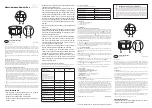
-
6-
Set E5 and E6 jumpers
to set up the unit for 4-wire or 6-wire connection. With a 4-wire
connection, 2 wires are used for signal and 2 wires for excitation. With a 6-wire connec-
tion, an additional 2 wires are used to sense the excitation voltage at the sensor, there-
by eliminating errors due to voltage drop in the excitation leads.
Excitation Connection
4-wire
6-wire
E5
jumper
install*
none
E6
jumper
install*
none
* Factory default setting
Set the E7 jumper
for
use of the unit’s on-board standard 87.325 kΩ shunt calibration
resistor. Do not set the E7 jumper for use of a user-furnished custom shunt calibration
resistor.
Calibration Resistor
Standard
Custom
E7
jumper
install*
none
* Factory default setting
A custom shunt calibration resistor, if used, is inserted into two single-pin sockets on the
circuit board, as shown in Figure 3. Cut and bend the leads so that the resistor will fit
into the case when closed.
The selected resistor (standard or custom) is connected to the circuit by pressing the
pushbutton switch at SW1, which is accessible through a hole in the top of the case.
Push-button switch at SW1
Custom shunt calibration resistor
Single-pin socket for resistor leads
Figure 3.
Custom shunt calibration resistor



































